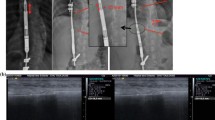Abstract
Purpose
Growing rod surgeries are common methods in the treatment of early onset scoliosis. Magnetic growing rod (MGR) surgery, in particular, has become more widespread in the last 10 years. The aim of this study was to compare the effects of traditional and magnetically controlled growing rod techniques on efficacy, safety, spinal growth, and lung development.
Methods
A retrospective analysis was made of 24 TGR and 17 MGR patients. Inclusion criteria were patients aged < 10 years, curvature > 40° or a progression of > 10° in the 4–6 month follow-up for curves between 25 and 40°.
Results
There were 9 males and 15 females in the TGR cohort and 7 males and 10 females in the MGR cohort. The mean age at first surgery was 6.1 years and 7.1 years, respectively. Major curve Cobb angles of TGR were preop. 51.5°, postop. 21.4° and 18.1° at the final follow-up. In the MGR cohort, these values were 60.4°, 41.8°, and 36.4°, respectively. The mean T1-S1 lengthening velocity was calculated as 1.12 cm/year (0.9318 mm/month) in the TGR group and 1.27 cm/year (1.0571 mm/month) in the MGR group. In the TGR cohort, a total of 99 procedures were performed as 24 initial surgeries and 75 additional procedures (5 lengthening during unplanned surgery due to complications; 4 revision, 1 debridement). In the MRG cohort, a total of 25 surgical procedures were performed as 17 initial surgeries and 7 additional procedures (3 debridements, 5 revisions).
Conclusion
The results of this study showed that the TGR system provided better correction in the coronal plane and was superior in kyphosis restoration than the MGR system. Both methods were successful in lengthening, but complication rates were slightly higher in the MGR cohort. The most common complication was the pullout of the proximal anchors, and this was more common in the MGR. Both TGR and MGR were found to be effective treatments. Lengthening without surgery is a significant advantage of the MGR system, but it has a high revision rate, and Cobb angle correction was found to be less effective than with TGR.







Similar content being viewed by others
References
Dimeglio A, Canavese F (2012) The growing spine: how spinal deformities influence normal spine and thoracic cage growth. Eur Spine J 21(1):64–70. https://doi.org/10.1007/s00586-011-1983-3
Akbarnia BA et al (2013) Next generation of growth-sparing techniques: preliminary clinical results of a magnetically controlled growing rod in 14 patients With early-onset scoliosis. Spine (Phila Pa 1976) 38(8):665–670. https://doi.org/10.1097/BRS.0b013e3182773560
Thompson GH et al (2005) Comparison of single and dual growing rod techniques followed through definitive surgery. Spine (Phila Pa 1976) 30(18):2039–2044. https://doi.org/10.1097/01.brs.0000179082.92712.89
Atici Y et al (2015) The effect of growing rod lengthening technique on the sagittal spinal and the spinopelvic parameters. Eur Spine J 24(6):1148–1157. https://doi.org/10.1007/s00586-014-3422-8
Ilharreborde B (2018) Sagittal balance and idiopathic scoliosis: does final sagittal alignment influence outcomes, degeneration rate or failure rate? Eur Spine J 27(S1):48–58. https://doi.org/10.1007/s00586-018-5472-9
Akbarnia BA et al (2008) Dual growing rod technique followed for three to eleven years until final fusion. Spine (Phila Pa 1976) 33(9):984–990. https://doi.org/10.1097/BRS.0b013e31816c8b4e
Thakar C, Kieser DC, Mardare M, Haleem S, Fairbank J, Nnadi C (2018) Systematic review of the complications associated with magnetically controlled growing rods for the treatment of early onset scoliosis. Eur Spine J 27(9):2062–2071. https://doi.org/10.1007/s00586-018-5590-4
Harshavardhana NS, Noordeen MHH, Dormans JP (2019) Cost analysis of magnet-driven growing rods for early-onset scoliosis at 5 years. Spine (Phila Pa 1976) 44(1):60–67. https://doi.org/10.1097/BRS.0000000000002738
Charron C et al (2014) Direct costs associated with the management of progressive early onset scoliosis: estimations based on gold standard technique or with magnetically controlled growing rods. Orthop Traumatol Surg Res 100(5):469–474. https://doi.org/10.1016/j.otsr.2014.05.006
Doany ME et al (2018) Health-related quality of life in early-onset scoliosis patients treated surgically: EOSQ scores in traditional growing rod versus magnetically controlled growing rods. Spine (Phila Pa 1976) 43(2):148–153. https://doi.org/10.1097/BRS.0000000000002274
Author information
Authors and Affiliations
Corresponding author
Ethics declarations
Conflict of interest
None of the authors has any potential conflict of interest.
Additional information
Publisher's Note
Springer Nature remains neutral with regard to jurisdictional claims in published maps and institutional affiliations.
Rights and permissions
Springer Nature or its licensor (e.g. a society or other partner) holds exclusive rights to this article under a publishing agreement with the author(s) or other rightsholder(s); author self-archiving of the accepted manuscript version of this article is solely governed by the terms of such publishing agreement and applicable law.
About this article
Cite this article
Samadov, F., Ozdemir, H.M., Talmac, M.A. et al. Traditional versus magnetically controlled growing rods in early onset scoliosis surgical treatment. Eur Spine J 32, 889–898 (2023). https://doi.org/10.1007/s00586-023-07553-3
Received:
Revised:
Accepted:
Published:
Issue Date:
DOI: https://doi.org/10.1007/s00586-023-07553-3




